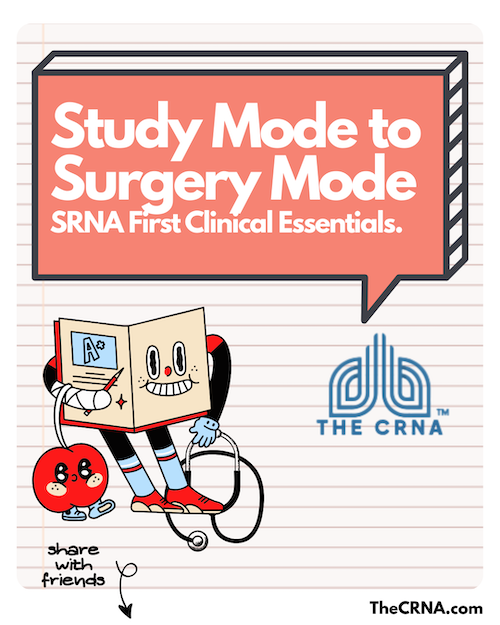Transitioning from the classroom to the operating room is one of the biggest milestones in SRNA training. The shift from theory to practice is exciting, but it can also feel intimidating as you’re expected to apply classroom knowledge in real-time, high-pressure situations. The first few weeks of clinicals often test your confidence, adaptability, and ability to prioritize. The good news is that every SRNA starts here — feeling a mix of nerves and anticipation — and with the right preparation, you’ll quickly begin to build confidence. By focusing on strong fundamentals, good habits, and professional presence, you can transform that initial anxiety into steady growth. Below are the essentials to help you bridge the gap between study mode and surgery mode and step into your clinicals with purpose.

Master the Fundamentals
- Know your drugs: dosages, mechanisms, and side effects.
- Review your assigned cases ahead of time.
- Have primary, secondary, and backup care plans — risk mitigation is key in anesthesia.
- Be ready to explain the reasoning behind your clinical decisions.
Develop Strong Organization & Preparation Habits
- Arrive early to review patient charts and OR assignments.
- Keep a small pocket notebook for quick notes and reminders.
- Build a disciplined routine: prepare for the next day, then rest.
- Maintain a steady sleep schedule to stay sharp.
Essential Tools & Supplies
- Stethoscope, good pens, and possibly a Sharpie.
- Pocket notebook for drug doses, notes, and checklists.
- Optional: trauma shears or a small multitool (depending on facility policy).
Helpful Apps & Resources
- Vargo App – drug dosages, case prep, and anesthesia references.
- MasterAnesthesia – free alternative for early learning.
- AnesthesiaConsiderations.com – strong reference for perioperative considerations.
- UpToDate – if your program or hospital provides access.
Professionalism & Clinical Etiquette
- Bring a teachable, positive attitude every day.
- Learn the team’s culture, humor, and workflow to adapt smoothly.
- Ask for feedback at the end of the day to show you’re committed to growth.
- Avoid distractions: take notes on paper instead of using your phone in the OR.
Comfort & Self-Care in the OR
- If allowed, use a chair during downtime.
- Keep a phone charger in your bag.
- Maintain healthy routines (meals, sleep, exercise) and prioritize rest to prevent burnout.
- Be prepared to handle challenging personalities — flexibility is essential in this role.
Clinical training is where you begin to transform into a confident, competent anesthesia provider. Every day in the OR is an opportunity to sharpen your knowledge, improve your skills, and learn from the experienced clinicians guiding you. You’ll encounter challenges, but with preparation, humility, and persistence, you’ll find your confidence grows. Remember — no one expects perfection on day one; they expect commitment, effort, and the ability to learn. By mastering the fundamentals, staying organized, showing professionalism, and taking care of yourself, you’ll not only survive your first clinicals — you’ll thrive in them. Approach each day with curiosity, discipline, and resilience, and you’ll be laying the foundation for a long, successful CRNA career.


